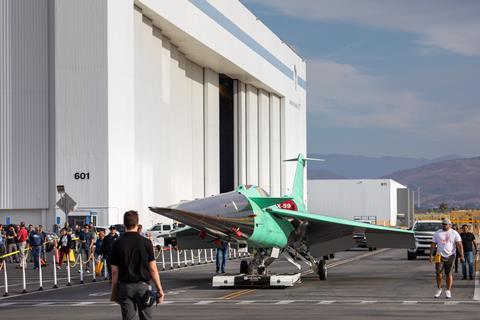NASA and partner Lockheed Martin are evaluating a newly discovered flight-control problem with the agency’s X-59 supersonic demonstrator jet, and have moved the aircraft back inside for evaluation.
The so-called “low-boom demonstrator” aircraft had previously been parked in a tent-like enclosure called a “run-stall” on the flight line at Lockheed’s Skunk Works facility in Palmdale, California.
NASA and Lockheed had been performing ground-based tests on the aircraft when the flight-control issue arose.
“It did a command that we didn’t expect,” says NASA chief X-59 engineer Jay Brandon. “We stopped that testing… We drained all the fuel from the airplane and we brought it back into the production Area L”.

That area is where Lockheed’s Skunk Works division assembled the jet. The contractor in 2016 won a contract to develop X-59 as part of NASA’s Quiet Supersonic Technology programme.
Powered by a single a single 22,000lb-thrust (98kN) GE Aviation F414-GE-100, X-59 has design features intended reduce the loudness of a supersonic aircraft’s sonic boom. NASA expects the single-pilot jet will fly at about Mach 1.4.
The programme is already delayed, with NASA in 2020 previously aiming to have the aircraft flying in 2021.
Despite the new flight-control issue, NASA says it is sticking with an existing plan to have X-59 airborne this year.
“But that’s all contingent on… getting all the integrated tests done [and] getting ourselves comfortable” with the performance of the aircraft’s systems, says Brandon.
The issue arose during “structural-coupling” tests, which involve evaluation of “aero-servo elasticity”, Brandon adds. Aero-servo elasticity refers to the complex interaction between flexible aircraft structures, aerodynamic forces and advanced flight-control systems.
“Recent X-59 system testing did identify an unexpected response related to the flight controls, which is now being addressed before proceeding with further systems testing,” says Lockheed Martin Skunk Works.
Lockheed helped design X-59’s flight-control system, and partner companies supplied components, says Brandon. Neither he nor Lockheed name those partners.

NASA in July said the team had moved X-59 from Area L to the run-stall, where they began tests. Those included “free-play” tests to determine “how much movement the control surfaces have”, and structural-vibration tests that involved using “shakers… to excite its various bending modes”, Brandon says. Engineers used accelerometers to measure vibrations, collecting data useful for verifying and improving models.
“The airplane has a lot of those different [vibration] modes that happen at different frequencies,” including longitudinally and laterally, such as wings bending, he adds.
Then came structural-coupling tests, during which the team identified the flight-control problem.
“We completed the first configuration of five planned [structural-coupling test] configurations… and then we had some issues with our flight-control computers,” Brandon says. “We stopped that testing until we get the flight-control computer issue solved, and then we’ll go back and finish that later.”
Asked about the problem, Brandon notes that design features intended to soften X-59’s boom make it an inherently “unstable airplane”. Engineers therefore gave the jet a “full-authority digital flight-control system” – it provides stability, making control adjustments in response to “feedbacks from sensors on the airplane”.
“The control system has to be in there, and has to be working all the time to… keep it under control and to get decent… flying qualities,” Brandon says.
But problems can arise if, for instance, the flight-control system does not properly distinguish between whole-aircraft movements and structural changes like a bending wing. That can create scenarios when the system starts to “work against something that’s not happening on the overall airplane”.
“X-59 is currently undergoing integrated, powered testing and troubleshooting to verify and ensure proper functionality of the systems and software on the aircraft,” says Lockheed. “It is part of normal aircraft development to identify and resolve any problems during ground test before proceeding to engine runs, taxi and flight, and to have periodic stand-down periods to implement hardware and software changes to resolve any findings.”
NASA’s Brandon describes the issue as a consequence of developing a complex clean-sheet aircraft using components sourced from various suppliers. The team used many off-the-shelf parts for the demonstrator, including those from Northrop Grumman T-38s, Boeing F-15s and F/A-18s, and Lockheed F-16s.
Those parts “have to somehow hold hands and be happy”, Brandon says. Also, the aircraft is so small – measuring 30.4m (99.7ft) long – that finding room for those components is challenging. “[Those are] the issues we are working on, and that brought us back into Area L”.
NASA says it intends this year to roll-out X-59 with a fresh coat of exterior paint.
After first flight, Brandon expects the team will spend about nine months flight-testing the aircraft, completing about 60 flights. It will then begin a period of measuring X-59’s sonic boom. Next, NASA plans to complete “community” surveys over about three years, which will involve evaluating how people on the ground experience X-59’s sonic boom.
The jet’s design should give it a sonic boom of about 75db when heard from the ground, or roughly equivalent to a neighbour shutting a car door, NASA says. By comparison, Concorde had a boom of 105dB.
NASA hopes the Federal Aviation Administration will use data from the programme to do away with a 50-year prohibition against overland supersonic civilian flight.


























